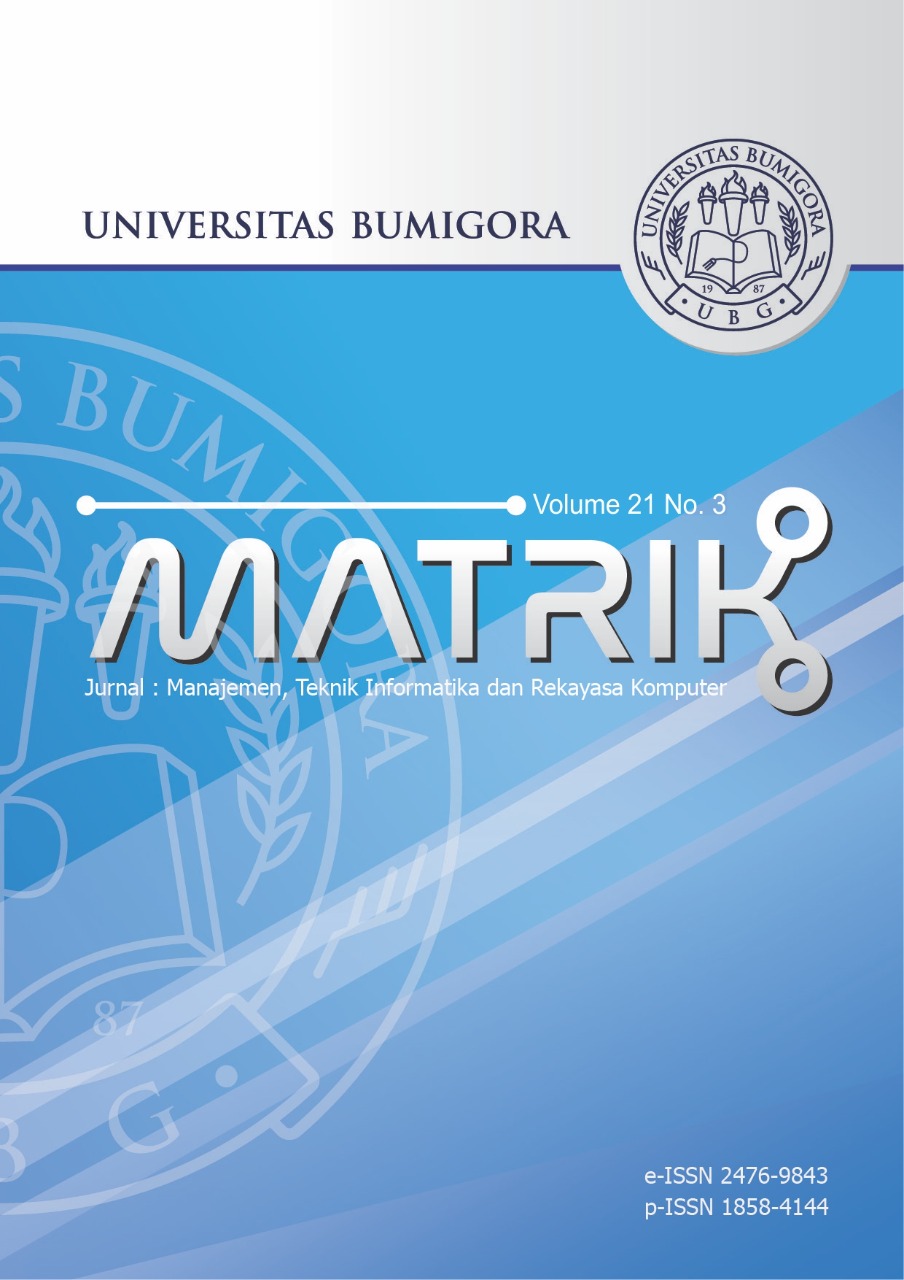Sentiment Analysis of Food Order Tweets to Find Out Demographic Customer Profile Using SVM
DOI:
https://doi.org/10.30812/matrik.v21i3.1898Keywords:
Classification, Demographic Profile, Machine Learning, Sentiment Analysis, TweetsAbstract
The use of online food ordering through food systems or applications continues to increase, requiring vendors to implement marketing and sales strategies through surveys, feedback. The problems that arise are building a system analysis model from a collection of tweets with hashtags or usernames for ordering food online . The Support Vector Machine (SVM) algorithm is used for text classification. Tweets are collected into data sets, training data, and testing data, then a classification model of the SVM Algorithm is built. Preprocessing data, tweets are cleansing, tokenized, and stopword remove. From the collected tweets, they are grouped into 10 variables to identify demographic profiles. The results of the analysis are classified as positive sentiments, namely residence, price range, using promos, paid types, halal food while negative sentiments are ethnicity, culture, vegetarianism, place. Classification accuracy is important to validate the results of the SVM model. From 500 train data tweet, the resulting classification is 66% positive sentiment and 34% negative sentiment. Overall accuracy model Linier SVM result 83.2% with accuracy 92.55%.
Downloads
References
Algoritma Support Vector Machine,†MATRIK : Jurnal Manajemen, Teknik Informatika dan Rekayasa Komputer, vol. 20, no. 2,
pp. 407–416, 2021.
[2] W. Bourequat and H. Mourad, “Sentiment Analysis Approach for Analyzing Iphone Release Using Support Vector Machine,â€
International Journal of Advances in Data and Information Systems, vol. 2, no. 1, pp. 36–44, 2021.
[3] S. Dey, S. Wasif, D. S. Tonmoy, S. Sultana, J. Sarkar, and M. Dey, “A Comparative Study of Support Vector Machine and
Naive Bayes Classifier for Sentiment Analysis on Amazon Product Reviews,†2020 International Conference on Contemporary
Computing and Applications, IC3A 2020, no. May, pp. 217–220, 2020.
[4] A. N. Rosyad, R. Syarief, and M. F. Syuaib, “Business Model Development Strategy for Frozen Food Micro-Business in The
New Normal Era (Case Study : CV XYZ) ,†vol. 8, no. 1, pp. 93–103, 2022.
[5] C. Villavicencio, J. J. Macrohon, X. A. Inbaraj, J. H. Jeng, and J. G. Hsieh, “Twitter Sentiment Analysis Towards Covid-19
Vaccines in The Philippines Using Na¨ıve Bayes,†Information (Switzerland), vol. 12, no. 5, 2021.
[6] M. Boukabous and M. Azizi, “Crime Prediction using A Hybrid Sentiment Analysis Approach Based on The Bidirectional
Encoder Representations From Transformers,†Indonesian Journal of Electrical Engineering and Computer Science, vol. 25,
no. 2, pp. 1131–1139, 2022.
[7] E. M. Sari Rochman, I. Oktavia Suzanti, Imamah, M. Ali Syakur, D. R. Anamisa, A. Khozaimi, and A. Rachmad, “Classification
of Thesis Topics Based on Informatics Science Using SVM,†IOP Conference Series: Materials Science and Engineering, vol.
1125, no. 1, p. 012033, 2021.
[8] R. Amalia, M. A. Bijaksana, and D. Darmantoro, “Negation Handling in Sentiment Classification Using Rule-Based Adapted
From Indonesian Language Syntactic for Indonesian Text in Twitter,†Journal of Physics: Conference Series, vol. 971, no. 1,
2018.
[9] A. Faesal, A. Muslim, A. H. Ruger, and K. Kusrini, “Sentimen Analisis Terhadap Komentar Konsumen Terhadap Produk
Penjualan Toko Online Menggunakan Metode K-Means,†MATRIK : Jurnal Manajemen, Teknik Informatika dan Rekayasa
Komputer, vol. 19, no. 2, pp. 207–213, 2020.
[10] M. Tika Adilah, H. Supendar, R. Ningsih, S. Muryani, and K. Solecha, “Sentiment Analysis of Online Transportation Service
Using The Na¨ıve Bayes Methods,†Journal of Physics: Conference Series, vol. 1641, no. 1, 2020.
[11] S. Wadhwa, “Performance Comparison of Classifiers on Twitter Sentimental Analysis,†pp. 50–61, 2022.
[12] S. P. Kristanto and L. Hakim, “Ekstraksi Informasi DestinasiWisata Populer Jawa Timur Menggunakan Depth-First Crawling,â€
MATRIK : Jurnal Manajemen, Teknik Informatika dan Rekayasa Komputer, vol. 21, no. 1, pp. 229–236, 2021.
[13] B. J. Gogoi, “Changing Consumer Preferences: Factors Influencing Choice of Fast Food Outlet,†Academy of Marketing Studies
Journal, vol. 24, no. 1, pp. 1–17, 2020.
[14] M. Schmitt, S. Steinheber, K. Schreiber, and B. Roth, “Joint Aspect and Polarity Classification for Aspect-Based Sentiment
Analysis with End-to-End Neural Networks,†Proceedings of the 2018 Conference on Empirical Methods in Natural Language
Processing, EMNLP 2018, pp. 1109–1114, 2020.
[15] D. E. Kurniawati and R. Z. Khoirina, “Online-Based Transportation Business Competition Model of Gojek and Grab,†Advances
in Social Science, Education and Humanities Research, vol. 436, pp. 1054–1057, 2020.
[16] F. R. Azmi, H. Musa, S. H. M. Zailani, and S. F. Fam, “Analysis of Mitigation Strategy for Operational Supply Risk: An
Empirical Study of Halal Food Manufacturers in Malaysia,†Uncertain Supply Chain Management, vol. 9, no. 4, pp. 797–810,
2021.
Downloads
Published
Issue
Section
How to Cite
Similar Articles
- Siti Ummi Masruroh, Cong Dai Nguyen, Doni Febrianus, Comparative Analysis of TF-IDF and Modern Text Embedding for theClassification of Islamic Ideologies on Indonesian Twitter , MATRIK : Jurnal Manajemen, Teknik Informatika dan Rekayasa Komputer: Vol. 25 No. 1 (2025)
- Putu Tisna Putra, Anthony Anggrawan, Hairani Hairani, Comparison of Machine Learning Methods for Classifying User Satisfaction Opinions of the PeduliLindungi Application , MATRIK : Jurnal Manajemen, Teknik Informatika dan Rekayasa Komputer: Vol. 22 No. 3 (2023)
- Taufik Hidayat, Mohammad Ridwan, Muhamad Fajrul Iqbal, Sukisno Sukisno, Robby Rizky, William Eric Manongga, Determining Toddler's Nutritional Status with Machine Learning Classification Analysis Approach , MATRIK : Jurnal Manajemen, Teknik Informatika dan Rekayasa Komputer: Vol. 24 No. 2 (2025)
- Annisa Nurul Puteri, Suryadi Syamsu, Topan Leoni Putra, Andita Dani Achmad, Support Vector Machine for Predicting Candlestick Chart Movement on Foreign Exchange , MATRIK : Jurnal Manajemen, Teknik Informatika dan Rekayasa Komputer: Vol. 22 No. 2 (2023)
- Ahmad Zein Al Wafi, Febry Putra Rochim, Veda Bezaleel, Investigating Liver Disease Machine Learning Prediction Performancethrough Various Feature Selection Methods , MATRIK : Jurnal Manajemen, Teknik Informatika dan Rekayasa Komputer: Vol. 24 No. 3 (2025)
- Wahyu Styo Pratama, Didik Dwi Prasetya, Triyanna Widyaningtyas, Muhammad Zaki Wiryawan, Lalu Ganda Rady Putra, Tsukasa Hirashima, Performance Evaluation of Artificial Intelligence Models for Classification in Concept Map Quality Assessment , MATRIK : Jurnal Manajemen, Teknik Informatika dan Rekayasa Komputer: Vol. 24 No. 3 (2025)
- Nurun Latifah, Ramaditia Dwiyansaputra, Gibran Satya Nugraha, Multiclass Text Classification of Indonesian Short Message Service (SMS) Spam using Deep Learning Method and Easy Data Augmentation , MATRIK : Jurnal Manajemen, Teknik Informatika dan Rekayasa Komputer: Vol. 23 No. 3 (2024)
- Miftahuddin Fahmi, Anton Yudhana, Sunardi Sunardi, Image Processing Using Morphology on Support Vector Machine Classification Model for Waste Image , MATRIK : Jurnal Manajemen, Teknik Informatika dan Rekayasa Komputer: Vol. 22 No. 3 (2023)
- Ni Wayan Sumartini Saraswati, I Gusti Ayu Agung Diatri Indradewi, Recognize The Polarity of Hotel Reviews using Support Vector Machine , MATRIK : Jurnal Manajemen, Teknik Informatika dan Rekayasa Komputer: Vol. 22 No. 1 (2022)
- M Safii, Husain Husain, Khairan Marzuki, Support Vector Machine Optimization for Diabetes Prediction UsingGrid Search Integrated with SHapley Additive exPlanations , MATRIK : Jurnal Manajemen, Teknik Informatika dan Rekayasa Komputer: Vol. 25 No. 1 (2025)
You may also start an advanced similarity search for this article.
Most read articles by the same author(s)
- lili Tanti, Syahril Efendi, Maya Silvi Lydia, Herman Mawengkang, Model Dynamic Facility Location in Post-Disaster Areas in Uncertainty , MATRIK : Jurnal Manajemen, Teknik Informatika dan Rekayasa Komputer: Vol. 22 No. 1 (2022)


.png)












